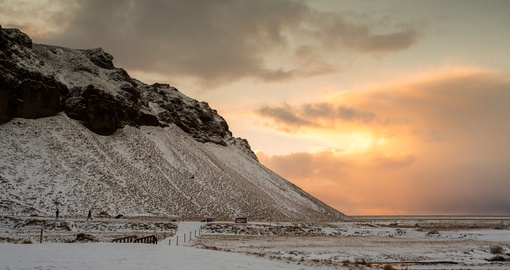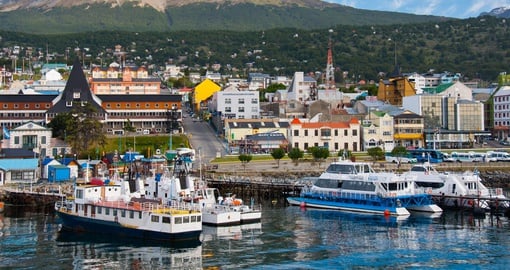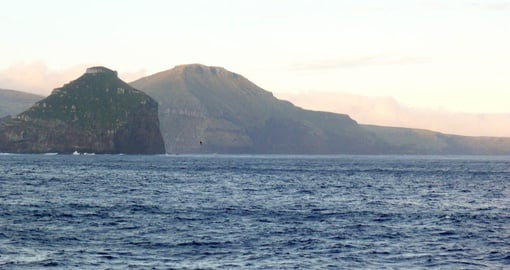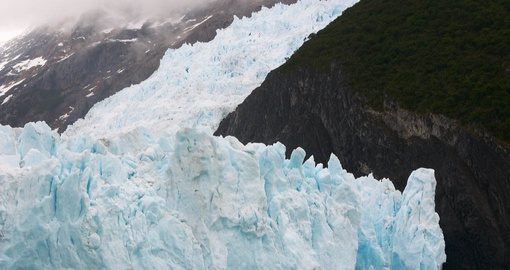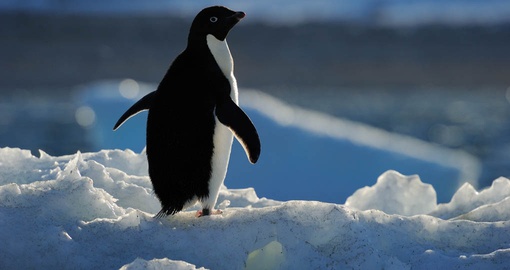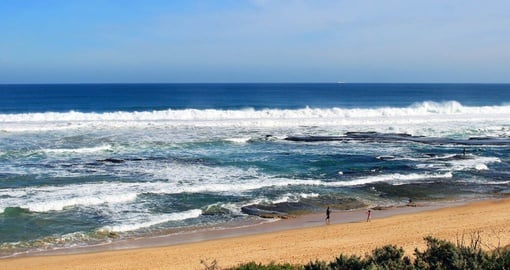Ross Sea including Helicopter Explorations: Argentina to New Zealand
- Duration
- 33 Days
- Prices:
- On request
Explore the southernmost reaches of the planet on this epic Antarctica vacation. Passing from Argentina to New Zealand, you’ll traverse the frozen oceans aboard a purpose-built ice cruiser, make landfall at far-flung locations on the Antarctic Peninsula, and visit remote islands and regions that few explorers ever reach.
This 32-day Antarctica vacation takes you across the expanse of the south ocean, passing from Argentina to New Zealand as you explore the icy reaches and frozen seas of Antarctica.
Your Antarctica vacation begins in Ushuaia, a frontier town pitched on the southern tip of South America. After chumming with fellow globetrotters in the town’s adventure bases, board the M/V Ortelius, an ice cruiser capable of accommodating up to 116-123 passengers. With 22 crew members, 19 hotel staff, and eight expedition specialists, M/V Ortelius is expertly-staffed and ideally-equipped to brave the south seas and offer passengers as much time on shore as possible. It offers the comforts of a hotel with the technical superiority of a scientific research vessel.
Aboard M/V Ortelius, you’ll cruise across the Lemaire Channel to the Antarctic Peninsula, where you’ll explore desolate landscapes that are home to fascinating wildlife. Make first landfall on Pleneau Island, where you’ll find fur seals, Gentoo penguins, kelp gulls, and south polar skuas. Continue on to Petermann Island to see more Gentoo penguins as well as Adelie penguins. You’ll also stop off in the First Islands, home to even more penguins and blue-eyed shags, before setting foot on the continent at Prospect Point.
It’s then back to the boat to cross the Bellingshausen Sea, a stretch of pack ice around the edge of the Antarctic continent. Within this stretch of icy waters, you’ll find Peter I Island, named after the Russian Tsar when it was discovered in 1821. Initially claimed by Norway, but eventually becoming its own territory, Peter I Island is usually skipped over by expeditionary vessels due to its exposure to the elements. Nevertheless, the M/V Ortelius is fully-equipped to helicopter passengers to the island if weather permits.
Continue your Antarctica vacation by sailing through the Amundsen Sea, on the fringes of the pack ice. You’ll pass along the west-flowing Antarctic coastline, spotting Emperor penguins and fur seals straggling on the ice floes. If you’re lucky, you might even see orcas and minke whales breach the icy waters.
Pass into the Ross Sea, known for the floating ice shelf with 30m-high fronts and subzero temperatures. You’ll spend a week exploring the terrain of the Ross Sea. Stop off in the Bay of Whales to see where Roald Amundsen reached the ice shelf in 1911 while en route to being the first person to reach the South Pole. On Ross Island, you’ll find the tallest peak on the continent, Mt. Erebus, which towers over Mt. Terror and Mt. Byrd, even as all three are famous spots for expeditions.
At Cape Royds, you’ll find the cabin of Ernest Shackleton, with old gear and even canned goods from Shackleton’s expedition filling the walls, preserved by over a century of cold. At Cape Evans, you’ll find the cabin of Robert Falcon Scott, where Scott stayed before achieving the South Pole. In the Ross Sea, you’ll be able to take full advantage of the M/V Ortelius’ helicopters, flying high over the Taylor Valley to see one of Antarctica’s famous Mars-like valleys, and connecting to various parts of the continent by air if sea conditions are treacherous.
You’ll close out your Antarctica vacation by attempting a landing at Cape Adare, where people first wintered on the Antarctic continent. The island is home to the largest colony of Adelie penguins in the world. Pass through the Southern Ocean and say goodbye to the continent with a final landing at Scott Island if weather permits. It’s then on to Campbell Island, a sub-Antarctic New Zealand Reserve that abounds with vegetation and all manner of penguins and seafaring birds. You’ll spot Eastern Rockhopper, Erect-Crested, and Yellow-Eyed Penguins while exploring the island. Disembark in Bluff, New Zealand, where you can extend your adventure by connecting to the rest of the country, or depart for home.
- Duration
- 33 Days
- Prices:
- On request
Itinerary View Trip Map
End of the World, Start of a Journey
Your voyage begins where the world drops off. Ushuaia, Argentina, reputed to be the southernmost city on the planet, is located on the far southern tip of South America. Starting in the afternoon, you embark from this small resort town on Tierra del Fuego, nicknamed "The End of the World," and sail the mountain-fringed Beagle Channel for the remainder of the evening.
| Meal Plan | Dinner |
|---|---|
| Duration | 32 Nights |
| Accommodation |
MV Ortelius |
| Location | View map |
-
MV Ortelius
The ice-strengthened vessel "Ortelius" is an excellent vessel for Polar expedition cruises in the Arctic and Antarctica, providing you with possibilities to adventure in remote locations such as the Ross Sea and Franz Josef Land. The vessel has the highest ice-class notation (UL1 equivalent to …
The ice-strengthened vessel "Ortelius" is an excellent vessel for Polar expedition cruises in the Arctic and Antarctica, providing you with possibilities to adventure in remote locations such as the Ross Sea and Franz Josef Land.
The vessel has the highest ice-class notation (UL1 equivalent to 1A) and is therefore very suitable to navigate in solid one-year sea ice and loose multi-year pack ice. "Ortelius" is a great expedition vessel for 116 passengers with lots of open-deck spaces.Facilities
- Bar
- Helicopter Pad
- Observation Deck
- Restaurant
Photo gallery
Photo 1 of 1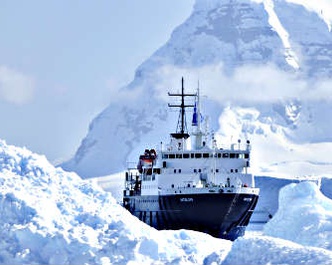
Path of the Polar Explorers
Over the next two days on the Drake Passage, you enjoy some of the same experiences encountered by the great polar explorers who first charted these regions: cool salt breezes, rolling seas, maybe even a fin whale spouting up sea spray. After passing the Antarctic Convergence - Antarctica's natural boundary, formed when north-flowing cold waters collide with warmer sub-Antarctic seas - you are in the circum-Antarctic upwelling zone.
| Meal Plan | Breakfast, Lunch and Dinner |
|---|
Path of the Polar Explorers
Not only does the marine life change, the avian life changes too. Wandering albatrosses, grey-headed albatrosses, black-browed albatrosses, light-mantled sooty albatrosses, cape pigeons, southern fulmars, Wilson's storm petrels, blue petrels, and Antarctic petrels are a few of the birds you might see.
| Meal Plan | Breakfast, Lunch and Dinner |
|---|
Through the Pendleton Strait
You arrive at the Antarctic Peninsula near the Antarctic Circle in the afternoon. If sea ice allows it, you can then continue through Pendleton Strait and attempt a landing at the rarely visited southern tip of Renaud Island. Here you have the opportunity to see the first Adélie penguins of the trip as well as enjoy spectacular views of the icebergs in this surreal, snow-swept environment.
| Meal Plan | Breakfast, Lunch and Dinner |
|---|
Sailing at Bellingshausen Sea
From the peninsula you head toward the open sea, your course set for Peter I Island.
| Meal Plan | Breakfast, Lunch and Dinner |
|---|
Bellingshausen Sea
Sail the Bellingshausen Sea where the first pack-ice may be seen.
| Meal Plan | Breakfast, Lunch and Dinner |
|---|
A rare glimpse of Peter I Island
Known as Peter I Øy in Norwegian, this is an uninhabited volcanic island in the Bellingshausen Sea. It was discovered by Fabian von Bellingshausen in 1821 and named after Peter the Great of Russia. The island is claimed by Norway and considered its own territory, though it is rarely visited by passenger vessels due to its exposed nature. If weather and ice conditions allow, you may enjoy a helicopter landing on the glaciated northern part of the island. This is a unique chance to land on one of the most remote islands in the world.
| Meal Plan | Breakfast, Lunch and Dinner |
|---|
Sights of the Amundsen Sea
You then sail through the Amundsen Sea, moving along and through the outer fringes of the pack ice.
| Meal Plan | Breakfast, Lunch and Dinner |
|---|
Sights of the Amundsen Sea
Ice conditions are never the same from year to year, though we aim to take advantage of the opportunities that arise if sea ice is present.
| Meal Plan | Breakfast, Lunch and Dinner |
|---|
Sights of the Amundsen Sea
Emperor penguins, groups of seals lounging on the ice floes, orca and minke whales along the ice edge, and different species of fulmarine petrels are possible sights in this area.
| Meal Plan | Breakfast, Lunch and Dinner |
|---|
Sights of the Amundsen Sea
At Sea.
| Meal Plan | Breakfast, Lunch and Dinner |
|---|
Sights of the Amundsen Sea
At Sea.
| Meal Plan | Breakfast, Lunch and Dinner |
|---|
Sights of the Amundsen Sea
At Sea.
| Meal Plan | Breakfast, Lunch and Dinner |
|---|
Sights of the Amundsen Sea
At Sea.
| Meal Plan | Breakfast, Lunch and Dinner |
|---|
The epic Ross Ice Shelf
The next goal is to enter the Ross Sea from the east, venturing south toward the Bay of Whales and close to Roosevelt Island (named in 1934 by the American aviator Richard E. Byrd for President Franklin D. Roosevelt).
| Meal Plan | Breakfast, Lunch and Dinner |
|---|
The epic Ross Ice Shelf
The Bay of Whales is part of the Ross Ice Shelf, the largest ice shelf in the world, and is constantly changing with the receding ice masses. Large icebergs are present here, along with great wildlife opportunities. Roald Amundsen gained access to the shelf en route to the South Pole, which he reached on December 14, 1911. Also, the Japanese explore Nobu Shirase had his camp in this area in 1912, at Kainan Bay.
| Meal Plan | Breakfast, Lunch and Dinner |
|---|
The epic Ross Ice Shelf
You may make a helicopter landing on the ice shelf if conditions allow. During this part of the voyage, we will also cross the International Date Line.
| Meal Plan | Breakfast, Lunch and Dinner |
|---|
Highlights of the Ross Sea
Keeping to the Ross Sea, your aim is now to visit Ross Island.
| Meal Plan | Breakfast, Lunch and Dinner |
|---|
Highlights of the Ross Sea
In this location you can see Mount Erebus, Mount Terror, and Mount Byrd, as well as many other famous spots that played an important role in the British expeditions of the last century: Cape Royds, where Ernest Shackleton's cabin still stands; Cape Evans, where the cabin of Robert Falcon Scott can still be seen; and Hut Point, from which Scott and his men set out for the South Pole.
| Meal Plan | Breakfast, Lunch and Dinner |
|---|
Highlights of the Ross Sea
If ice is blocking the way but weather conditions are favorable, you may use the helicopters to land in one or more spots in this area. The American scientific base of McMurdo Station and New Zealand's Scott Base are other possible locations you might visit. From McMurdo Station you could also make a 10-km hike (6 miles) to Castle Rock, where there are great views across the Ross Ice Shelf toward the South Pole. Additionally, you may make a helicopter landing in Taylor Valley, one of the Dry Valleys, where conditions are closer to Mars than anywhere else on Earth.
| Meal Plan | Breakfast, Lunch and Dinner |
|---|
Exploring the Inexpressible
Sailing north along the west coast of the Ross Sea, you pass the Drygalski Ice Tongue and Terra Nova Bay.
| Meal Plan | Breakfast, Lunch and Dinner |
|---|
Exploring the Inexpressible
If ice conditions allow, you then land at Inexpressible Island, which has a fascinating history in connection to the less-known Northern Party of Captain Scott's expedition. It is also home to a large Adélie penguin rookery. Should sea ice prevent entry into Terra Nova Bay, you may head farther north to the protected area of Cape Hallett and its own Adélie rookery.
| Meal Plan | Breakfast, Lunch and Dinner |
|---|
The residents of Cape Adare
You next attempt a landing at Cape Adare, where for the first time humans wintered on the Antarctic Continent: The Norwegian Borchgrevink stayed in here 1899, taking shelter in a hut that to this day is surrounded by the largest colony of Adélie penguins in the world.
| Meal Plan | Breakfast, Lunch and Dinner |
|---|
Ross Sea to the Southern Ocean
Sailing through the sea ice at the entrance of the Ross Sea, you start your journey north through the Southern Ocean. The goal is to set a course for the Balleny Islands, depending on weather conditions.
| Meal Plan | Breakfast, Lunch and Dinner |
|---|
The windswept Balleny Islands
Your intended route is past Sturge Island in the afternoon, getting an impression of these windswept and remote islands before crossing the Antarctic Circle.
| Meal Plan | Lunch and Dinner |
|---|
Sailing among the seabirds
You once again enter the vast expanse of the Southern Ocean.
| Meal Plan | Breakfast, Lunch and Dinner |
|---|
Sailing among the seabirds
Seabirds are prolific on this leg, during which we hope to enjoy good weather conditions
| Meal Plan | Breakfast, Lunch and Dinner |
|---|
Sailing among the seabirds
At Sea.
| Meal Plan | Breakfast, Lunch and Dinner |
|---|
Macca aka Macquarie Island
Macca, also known as Macquarie Island, is a Tasmanian State Reserve that in 1997 became a World Heritage Site. The Australian Antarctic Division has its permanent base on this island, which Australian sealer Frederick Hasselborough discovered while searching for new sealing grounds. The fauna on Macquarie is fantastic, and there are colonies of king, gentoo, and southern rockhopper penguins - as well as almost one million breeding pairs of the endemic royal penguin. Elephant seals and various fur seal species, such as the New Zealand fur seal, are also present. .
| Meal Plan | Breakfast, Lunch and Dinner |
|---|
Northwest toward Campbell Island
Heading northwest to Campbell Island, you're once again followed by numerous seabirds.
| Meal Plan | Breakfast, Lunch and Dinner |
|---|
Campbell Island's Bounteous Birdlife
The plan today is to visit the sub-Antarctic New Zealand Reserve and UNESCO World Heritage Site of Campbell Island, enjoying its luxuriantly blooming vegetation. The fauna on Campbell Island is also a highlight, with a large and easily accessible colony of southern royal albatrosses on the main island. Breeding on the satellite islands are wandering, Campbell, grey-headed, black-browed, and light-mantled albatrosses. There are also three breeding penguin species present: eastern rockhopper, erect-crested, and yellow-eyed penguins. In the 18th century, seals in the area were hunted to extinction, but the elephant seals, fur seals, and sea lions have since recovered.
| Meal Plan | Breakfast, Lunch and Dinner |
|---|
Once more to the Southern Ocean
Take in the vast horizons of your final sea day before you reach New Zealand.
| Meal Plan | Breakfast |
|---|
Porting in New Zealand
Every adventure, no matter how sublime, must eventually come to an end. You disembark in Bluff, the southernmost town in New Zealand, and return home with memories that will accompany you wherever your next adventure lies.
| Meal Plan | Breakfast, Lunch and Dinner |
|---|
Other Information
DEPARTURES:
M/V Ortelius
2023: Jan 14; Feb 17*
* Voyages operates on a reverse itinerary
PRICE INCLUDES:
- All meals throughout the voyage aboard the ship including snacks, coffee and tea.
- All shore excursions and activities throughout the voyage by Zodiac.
- Program of lectures by noted naturalists and leadership by experienced expedition staff.
- Free use of rubber boots and snowshoes.
- During voyages Weddell Sea voyages: ship-to-shore helicopter transfers (with no specific amount of helicopter time guaranteed)
- Luggage transfer from pick-up point to the vessel on the day of embarkation, in Ushuaia.
- Pre-scheduled group transfer from the vessel to the airport in Ushuaia (directly after disembarkation).
- All miscellaneous service taxes and port charges throughout the program.
- Comprehensive pre-departure material.
PRICE EXCLUDES:
- International and regional airfare other than stated in inclusions
- Travel insurance
- Items of a personal nature
- Pre- and post- land arrangements
- Passport and visa expenses
- Meals ashore
- Excess baggage charges and all items of a personal nature such as laundry, bar, beverage charges and telecommunication charges
- The customary gratuity at the end of the voyages for stewards and other service personnel aboard (guidelines will be provided)
TERMS AND CONDITIONS:
Prices are "from" per person based on twin/double share accommodation and for travel in low season. Seasonal surcharges and blackout dates may apply. Limited seat/spaces and all pricing is subject to change and availability. Rates for single or triple travellers are available on request - please inquire
14 Jan 2023






